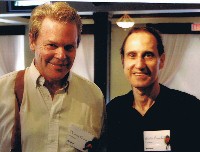
|
|
|
|
DRUPA
2000: A turning point in printing history By Burke Campbell and Murray Conron Perspectives, Vol. 7, No. 2, June 2000
DÜSSELDORF Xerox's Print Shop at DRUPA shows how print-on-demand
technologies will revolutionize industry. Five hundred years after Johannes Gutenberg introduced the
world's first moveable-type printing press and started a knowledge revolution,
Germany is once again the launching pad for a discovery that is expected to
change the world. This one concerns digital publishing and the printing of
individualized documents and it involves the shift from mechanical presses to
computerized digital printers. Unveiled here at the DRUPA 2000 trade show - the Olympics
of the printing and publishing industry, held once every five years - the
invention of the 21st millennium marks a turning point in the history of the
$950-billion book and newspaper publishing industry. It will, for instance, replace offset printing, now used
for mass production by newspapers and magazines and, with the new printing
technology, anyone can be a publisher. Eighteen Canadian printing and press manufacturers were
among the exhibitors at the two-week DRUPA trade show held in 18 separate halls
the size of aircraft hangars. The show, which ended May 31, drew about 400,000
visitors from all over the world. One of the largest exhibitors, Cambridge, Ont.-based Sanden
Inc. manufactures web-fed offset printing equipment for the forms, commercial,
direct mail and packaging industries. "Attending DRUPA is a necessity for our company,"
said Rosalee Sanden-Munch, president and CEO. The $50 million U.S. privately
owned firm has attended the show since 1972. The trade fair helps maintain
Sanden's visibility in the export market, which accounts for almost all of its
business. Sanden offers custom-engineered solutions to a global clientele, not
only in the U.S., but Saudi Arabia, Australia, and South Africa. "Although we don't make quick sales at the show, many
of our customers wait for this event to announce buying decisions and close
deals," said Ms. Sanden-Munch. Douglas Picklyk, editor of Print On Demand Business Canada,
a publication about digital printing, technology, and related business
practices, said that for the print industry, DRUPA is renowned as
"the" show. "In North America, regional shows preview the latest versions of technology, where exhibitors focus on making sales. But at DRUPA, you'll see advanced technology, even in prototype," he said. "You'll meet people actually involved in research and development. DRUPA shows us the present but also points out directions the whole industry will take." The future, according to DRUPA, belongs to digital
printing, supplanting offset printing, which relies on metal or plastic plates
to imprint ink on paper. Offset presses print accurately at high speed and are
economical for large runs. But with digital printing, computers store the
content in data files and drive the processes that apply ink to the paper. With digital printing, changes in output are effected by
simply changing the data on file. This permits quick formatting and easy
updates. Rather than printing for a broad audience, businesses can now target
their advertising to individuals and order smaller printing runs only as needed.
Because speed, clarity, and image resolution have improved and costs have
plummeted, digital printing is poised to supersede offset in this new
marketplace. Bookmaking is becoming so flexible and low cost that the
new printing technologies democratize the publishing industry. Anyone can be a
publisher. At DRUPA, Xerox demonstrated print-on-demand technologies in the
"Book Factory," part of a book shop that prints and binds complete
large volumes (say, 200 pages) in a matter of minutes. Bertelsmann AG, the
largest publisher in the industry, is working with Xerox to implement books on
demand. Xerox Corp. is in the throes of attempting the transition
from selling copiers to dominating the graphic arts industry. The company took
an empty warehouse on the DRUPA fairground, and in a "swat-team"
operation transformed it in a matter of days into a dazzling show palace for
"the new business of printing." A panoramic video welcomed the visitor
with a historical review of printing and a preview into the future. Meanwhile,
on the 66,000-square-foot-floor, viewers could explore the prolific production
capabilities of advanced color digital printing systems. "The graphic arts industry is key to Xerox's Canada's
business strategy," said Lawrence F. Vogel, manager of public relations for
Xerox Canada Ltd. Bound reproductions of the Gutenberg Bible were on display
in the Xerox hall as an example of the effort to preserve historical paper
documents, many of which are in peril of disintegration. Researchers estimate
that there are one billion historical documents in jeopardy in Europe alone. Stefan Egge, the Canadian representative of Messe Düsseldorf,
the German firm that organizes DRUPA, said the trade fair offers vendors a
global marketplace. "People come from all over the world to DRUPA. This
permits a vendor to pick and choose its audience," he said. Of the 200 trade fairs in the world, two-thirds are held in Germany. Such facts should encourage many Canadian businesses to investigate the global commercial crossroads that Germany affords. |
|